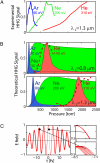Phase matching of high harmonic generation in the soft and hard X-ray regions of the spectrum
- PMID: 19541611
- PMCID: PMC2698889
- DOI: 10.1073/pnas.0903748106
Phase matching of high harmonic generation in the soft and hard X-ray regions of the spectrum
Abstract
We show how bright, tabletop, fully coherent hard X-ray beams can be generated through nonlinear upconversion of femtosecond laser light. By driving the high-order harmonic generation process using longer-wavelength midinfrared light, we show that, in theory, fully phase-matched frequency upconversion can extend into the hard X-ray region of the spectrum. We verify our scaling predictions experimentally by demonstrating phase matching in the soft X-ray region of the spectrum around 330 eV, using ultrafast driving laser pulses at 1.3-microm wavelength, in an extended, high-pressure, weakly ionized gas medium. We also show through calculations that scaling of the overall conversion efficiency is surprisingly favorable as the wavelength of the driving laser is increased, making tabletop, fully coherent, multi-keV X-ray sources feasible. The rapidly decreasing microscopic single-atom yield, predicted for harmonics driven by longer-wavelength lasers, is compensated macroscopically by an increased optimal pressure for phase matching and a rapidly decreasing reabsorption of the generated X-rays.
Conflict of interest statement
The authors declare no conflict of interest.
Figures





Similar articles
-
Generation of bright isolated attosecond soft X-ray pulses driven by multicycle midinfrared lasers.Proc Natl Acad Sci U S A. 2014 Jun 10;111(23):E2361-7. doi: 10.1073/pnas.1407421111. Epub 2014 May 21. Proc Natl Acad Sci U S A. 2014. PMID: 24850866 Free PMC article.
-
Coherent soft X-ray high-order harmonics using tight-focusing laser pulses in the gas mixture.J Xray Sci Technol. 2014;22(1):105-11. doi: 10.3233/XST-130412. J Xray Sci Technol. 2014. PMID: 24463389
-
Extended phase matching of high harmonics driven by mid-infrared light.Opt Lett. 2008 Sep 15;33(18):2128-30. doi: 10.1364/ol.33.002128. Opt Lett. 2008. PMID: 18794953
-
X-Ray Free-Electron Lasers for the Structure and Dynamics of Macromolecules.Annu Rev Biochem. 2019 Jun 20;88:35-58. doi: 10.1146/annurev-biochem-013118-110744. Epub 2019 Jan 2. Annu Rev Biochem. 2019. PMID: 30601681 Review.
-
Multidimensional attosecond resonant X-ray spectroscopy of molecules: lessons from the optical regime.Annu Rev Phys Chem. 2013;64:101-27. doi: 10.1146/annurev-physchem-040412-110021. Epub 2012 Dec 10. Annu Rev Phys Chem. 2013. PMID: 23245522 Free PMC article. Review.
Cited by
-
Nonlinear compression toward high-energy single-cycle pulses by cascaded focus and compression.Sci Adv. 2022 Aug 5;8(31):eabo1945. doi: 10.1126/sciadv.abo1945. Epub 2022 Aug 3. Sci Adv. 2022. PMID: 35921417 Free PMC article.
-
Super-resolution stimulated X-ray Raman spectroscopy.Nature. 2025 Jul;643(8072):662-668. doi: 10.1038/s41586-025-09214-5. Epub 2025 Jul 16. Nature. 2025. PMID: 40670638 Free PMC article.
-
Robust Isolated Attosecond Pulse Generation with Self-Compressed Subcycle Drivers from Hollow Capillary Fibers.ACS Photonics. 2024 Mar 18;11(4):1673-1683. doi: 10.1021/acsphotonics.3c01897. eCollection 2024 Apr 17. ACS Photonics. 2024. PMID: 38645995 Free PMC article.
-
Extension of the bright high-harmonic photon energy range via nonadiabatic critical phase matching.Sci Adv. 2022 Dec 23;8(51):eadd7482. doi: 10.1126/sciadv.add7482. Epub 2022 Dec 23. Sci Adv. 2022. PMID: 36563146 Free PMC article.
-
Optimal generation of spatially coherent soft X-ray isolated attosecond pulses in a gas-filled waveguide using two-color synthesized laser pulses.Sci Rep. 2016 Dec 8;6:38165. doi: 10.1038/srep38165. Sci Rep. 2016. PMID: 27929036 Free PMC article.
References
-
- Gagnon E, et al. Soft X-ray-driven femtosecond molecular dynamics. Science. 2007;317:1374–1378. - PubMed
-
- Sandhu AS, et al. Observing the creation of electronic Feshbach resonances in soft X-ray-induced O2 dissociation. Science. 2008;322:1081–1085. - PubMed
-
- Li W, et al. Time-resolved dynamics in N2O4 probed using high harmonic generation. Science. 2008;322:1207–1211. - PubMed
-
- Miaja-Avila L, et al. Direct measurement of core-level relaxation dynamics on a surface-adsorbate system. Phys Rev Lett. 2008;101:046101. - PubMed
Publication types
MeSH terms
LinkOut - more resources
Full Text Sources
Other Literature Sources
Medical

